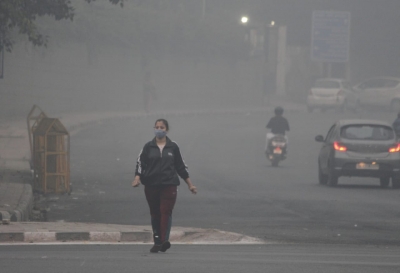GRAP has failed to bring about any change in Delhi-NCR's air quality: LIFE
By IANS | Published: November 14, 2021 09:27 AM2021-11-14T09:27:03+5:302021-11-14T09:35:15+5:30
New Delhi, Nov 14 At a time when the entire Delhi and the National Capital Region (NCR) are ...

GRAP has failed to bring about any change in Delhi-NCR's air quality: LIFE
New Delhi, Nov 14 At a time when the entire Delhi and the National Capital Region (NCR) are engulfed in toxic haze, the authorities have invoked the Graded Response Action Plan (GRAP), as is done every year, and there has been zilch improvement in the air quality, again, as has been witnessed for last few years.
That has put forth a question on the efficacy of the steps being taken and whether or not the government is doing the right thing! GRAP, as the name suggests, is a set of actions expected to be taken by the government and the community as per the severity of air pollution levels starting with post kharif harvest time and extending to peak winters and little beyond.
The sub-committee of the Commission on Air Quality Management for Delhi and its Surrounding Areas (CAQM) had earlier on Friday kicked in stringent provisions under the GRAP as the PM2.5 and PM10 concentrations breached the 300 and 500 threshold, respectively.
An analysis by the Legal Initiative for Forests and Environment (LIFE) has clearly showed that the number of days when the air quality can be categorised as "good" has not increased ever since GRAP has been implemented and that the data shows that the level of PM2.5 and PM10 remains high throughout the year in Delhi and NCR's four major towns Faridabad, Ghaziabad, Gurugram and Noida. LIFE is a non-profit taking up legal interventions on environmental matters and running advocacy and capacity building programmes to bring about awareness.
"The Graded Response Action Plan GRAP along with NCAP is designed to fail. Let's accept the hard reality: India does not have any plan to clean up its air. And no amount of knee jerk reaction during peak air pollution days are going to work," LIFE tweeted on Saturday with a link to the analysis.
GRAP was implemented for the first time in January 2017 and has since been implemented from autumn to winter season in the NCR. LIFE undertook the study to analyse the level of atmospheric concentration of PM2.5 and/or PM10 between January 12, 2017 till January 31, 2021 in Delhi and four other cities of NCR, i.e., Faridabad, Ghaziabad, Gurugram and Noida since the implementation of GRAP to assess its effectiveness in making air clean.
To start with, the analysis pointed out that the GRAP does not consider all the air pollutants...it only considers particulate matters, i.e., PM2.5 and PM10. "Thus, if the level of pollutants such as SO2 or NOX increases, GRAP does not come into effect," the analysis brought out in September 2021 said.
Further, the number of days when the air quality can be categorised as "good" has not increased ever since GRAP has been implemented, it said.
"It is clear that the level of particulate matter is high throughout the year, in which case GRAP as it exists today, needs to be implemented round the year," it added.
Incidentally, the GRAP notification states that it aims to address different levels of air pollution as per the Air Quality Index (AQI). "This is where the first major shortcoming of GRAP is ... in simple terms, the focus of GRAP is not on improving or bringing down the levels of all the air pollutants. It aims only at reducing the concentration of particulate matters, i.e., PM2.5 and PM10."
This effectively means that the levels of carbon monoxide, SO2, NO2, ozone, ammonia and other pollutants do not matter for GRAP.
The LIFE analysis of the last four years' data has shown that the season-wise number of days having mean PM10 concentration in "good" category is only one day each in the winter seasons of 2016-17 and 2020-21 while on most days it remained "moderate" to "severe". In fact, the mean concentration of PM10 reached "emergency" levels in the winter months for six and two days during the 2018-19 and 2020-21 respectively.
Now, while the GRAP kicks in only during winter pollution days, the PM10 concentration has reached "severe" or "emergency" levels in the summer and autumn seasons of all the years, except in 2020-21 (country-wide lockdown), it said.
"GRAP is faulty in terms of both its design and implementation. It cannot be corrected by improving implementation because many of its actions are impractical to be followed throughout the year," the analysis said, adding, "The NCR requires an effective year-round, long-term plan to improve its air quality. It should move beyond the exclusive focus on particulate matter and must focus, at the very least, on all the pollutants listed in the Air Quality Index if not on all those in the National Ambient Air Quality Standards, 2009."
Disclaimer: This post has been auto-published from an agency feed without any modifications to the text and has not been reviewed by an editor
Open in app